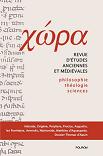InterprÉter l’ÉlÉgie parÉnÉtique archaïque : À propos de l’ouvrage de Magali AnnÉe sur TyrtÉe et Kallinos
InterprÉter l’ÉlÉgie parÉnÉtique archaïque : À propos de l’ouvrage de Magali AnnÉe sur TyrtÉe et Kallinos
Author(s): Xavier GheerbrantSubject(s): French Literature
Published by: EDITURA POLIROM S.A.
Keywords: paroenetic‑incantatory diction; testimonies;
Summary/Abstract: The book by Magali Année, Tyrtée et Kallinos (Paris, 2017), claims to establish new and ambitious grounds on which to found an interpretation of Tyrtaeus’ and Kallinos’ works. By analysing the underlining networks of phonic‑syllabic repetitions in the available fragments, she studies how those two poets have elaborated a paroenetic‑incantatory diction to make the audience accept the content of the exhortation as an already‑lived experience. For instance, she argues that any item in the phonic sequence ‑μεν/μην/μον/μν‑, even as a palindrome, refers to the action denoted by the verb μένειν, “to resist”. Année elaborates the conditions for the plausibility of her original interpretation through a re‑evaluation of the frameworks through which archaic poems are usually interpreted, and she proposes a new edition of the testimonies and fragments on the ground of radical textual conservatism. After summarising the author’s arguments in detail, I conclude that, in spite of their merits, they fail to meet the author’s objectives completely. I discuss in turn: how the author arranges the new edition of the testimonies and fragments; how she argues for her central view about phonic‑syllabic repetitions and the elaboration of the secondary layer of meaning; and how she analyses meter, which she presents as one of the bases for phonic‑pragmatic constructs; and how she conceives of her hermeneutical approach. On this last point, I specifically address the author’s view on the relationship between testimonies and fragments, the type of meaning she focuses on, the deconstruction of pre‑interpretations, and textual conservatism. I argue that the Année’s proposed underlying network of meaning comes at the expense of “meaning” in the more usual sense; we could however have expected her to elaborate on how her proposed layer of meaning enriches or enhances our understanding of the more usual layer. Tyrtée et Kallinos therefore represents an alternative to traditional interpretative approaches, with limits of its own, rather than a re‑founding.
Journal: Chôra. Revue d'études anciennes et médiévales
- Issue Year: 2019
- Issue No: 17
- Page Range: 259-298
- Page Count: 40
- Language: French
- Content File-PDF

